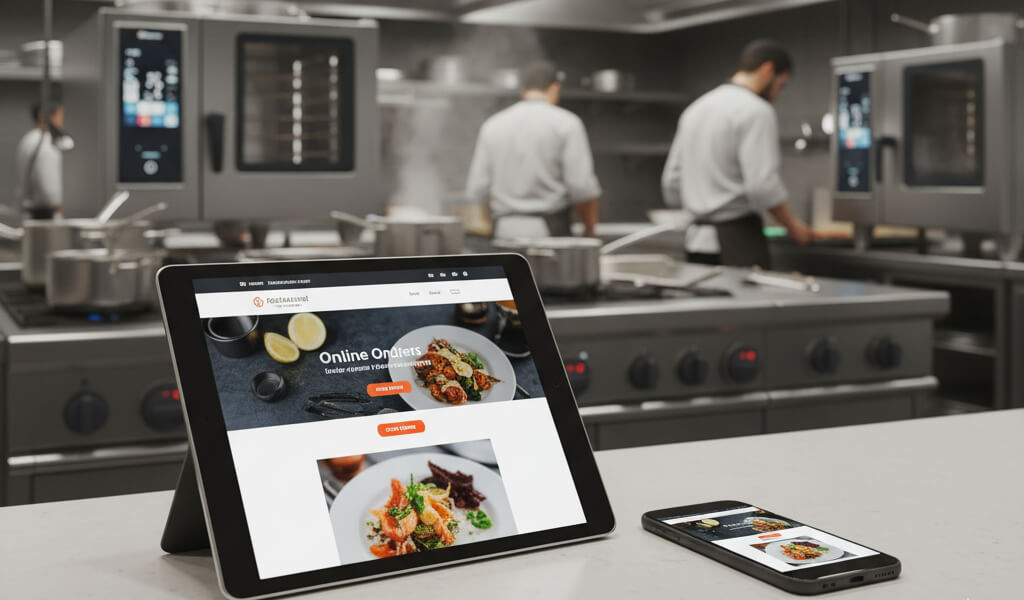October 02, 2025

In today’s rapidly evolving restaurant industry, integrating technology is no longer optional—it’s essential. One of the most significant advancements is the rise of smart kitchens, which leverage automation, the Internet of Things (IoT), and artificial intelligence (AI) to enhance efficiency, reduce waste, and improve food quality. However, as smart kitchen technology revolutionizes operations behind the scenes, how does this shift affect your restaurant's website and overall digital presence? Let’s explore the connection.
Smart kitchens are equipped with interconnected devices that enable real-time communication between various kitchen equipment, inventory systems, and customer-facing technologies. These technologies enhance operational efficiency, improve food quality, and drive sustainability. Here are some key features of smart kitchens:
These technologies work together to create an intelligent kitchen environment that enhances service speed, food quality, and operational efficiency.
With smart kitchens in place, orders from your website are processed more efficiently and accurately. A well-integrated system ensures that when a customer places an order online, the order is sent immediately to your kitchen, and the kitchen staff is alerted in real-time.
This direct flow of information between the front-of-house (website) and back-of-house (kitchen) eliminates potential errors, delays, or miscommunications. For instance, if a menu item is unavailable, your system can instantly update the website and prevent customers from ordering it.
Why it matters:
Learn more about adding online ordering to your website.
One of the most significant benefits of smart kitchens is their ability to track real-time data, such as menu item availability, cooking times, and inventory levels. This data can be integrated with your website, allowing you to update menus dynamically based on what’s available in the kitchen.
For example, if an ingredient runs low or if a dish is temporarily unavailable due to a supply issue, your website can automatically reflect these changes, preventing customers from ordering items that aren't available.
Why it matters:
For insights on how diners expect up-to-date menus, see guide on dining trends in 2025.
Smart kitchens can help track sustainability efforts, such as energy usage, waste reduction, and water conservation. These metrics not only help improve operational efficiency but can also be an excellent marketing tool.
By displaying sustainability metrics on your restaurant’s website, you show customers that you're committed to environmentally responsible practices. Eco-conscious diners will appreciate the transparency and may be more likely to choose your restaurant over others.
Why it matters:
For further insights on how sustainability impacts the restaurant industry, refer to the National Restaurant Association – Sustainability in Restaurants.
Smart kitchen integration can also enhance customer experience in terms of reservations and table management. Smart systems can analyze order patterns, wait times, and table turnover, optimizing the flow of customers and improving reservations management.
With this data, you can adjust reservation times and table allocations based on real-time kitchen capacity, ensuring faster and more efficient service.
Why it matters:
By linking your reservation system directly to your website, you eliminate the need for third-party booking apps, which means you keep more of your revenue and build a stronger customer relationship.
Cut the Middleman – Future-Proof Your Restaurant.
With most customers browsing restaurant menus on their smartphones, it’s crucial that your website is mobile-first. A mobile-optimized site allows customers to view real-time menu updates, place orders, and even track their food status while on the go.
Additionally, smart kitchen data (like order status, cooking times, or kitchen wait times) can be seamlessly integrated into your mobile-friendly website, ensuring customers have access to the information they need, no matter where they are.
Why it matters:
To optimize your website, see The Ultimate Restaurant Website Checklist, which provides a detailed guide for enhancing mobile UX and design. Additionally, check out The ROI of a Restaurant Website to understand how tech integration can improve revenue.
Smart kitchens are transforming the way restaurants operate, but to truly leverage their potential, your restaurant’s website must evolve alongside the technology. From dynamic, real-time menus and seamless online ordering to sustainability metrics and optimized reservation systems, your website serves as the bridge between smart kitchen technology and customer engagement.
Investing in a smart kitchen is just the beginning—without a cohesive digital presence, much of its potential is left untapped. Make sure your website is up to the challenge by incorporating these innovations and ensuring that your digital presence is as forward-thinking as the technology running your kitchen.
For a complete roadmap to optimizing your restaurant’s website, visit The Ultimate Restaurant Website Checklist and stay ahead of the curve with smart technology integrations.
This expanded version provides a deeper dive into how smart kitchen technology directly impacts website functionality, customer experience, and operational efficiency.
Stay up to date with the latest tips, expert insights, product reviews, and step-by-step guides to help you grow, create, and succeed—no matter your industry or passion.